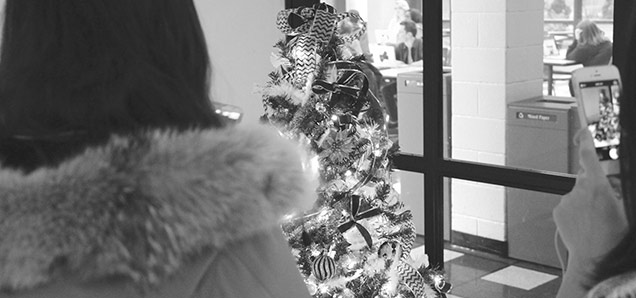Fir real: Christmas tree debate settled
 CREDIT: STEPHANIE LAI
CREDIT: STEPHANIE LAIWhat's more eco-friendly? Cutting down a real one every year or reusing a fake tree?0
As the holidays approach, the debate between artificial and real Christmas trees spreads like wildfire. Which is better for the environment? This year, you can save politics and religion to discuss with your offbeat uncle, because a conclusion has finally been reached.
With environmentalism and a more grassroots mentality experiencing a major jolt in popularity, this debate has gotten so much publicity that industry bigwigs like David Suzuki, Ellipsos and other news outlets are weighing in on the subject.
“Both sides have made valid points: advocates of artificial trees take issue with the practice of cutting down trees in the name of festivity, whereas proponents of real trees argue that it’s pretty much impossible for a plastic alternative to be green,” addressed Suzuki, a world renowned environmentalist, on his blog Queen of Green.
Ellipsos is a Canadian consulting firm concerned with sustainability.
“From an environmental perspective, this question raises many passions, since both type of trees seem to have advantages and drawbacks,” wrote an Ellipsos representative in an introduction to their French study, Au seceours! La planète se meurt et mon boss s’en fout, that aims to answer the question.
Ellipsos used a method of research called a Life Cycle Assessment, where a product’s environmental aspects are studied from the moment of its conception through its disposal and eventual destruction.
Although it may initially seem like an artificial tree is better for the environment because you’re not directly chopping one down – something that understandably has a more visceral feel of affecting the environment – they have their drawbacks as well.
It is beneficial that they can be used year after year, but manufacturing and transportation should also be considered.
Some Christmas trees are made of PVC, a potent emitter of greenhouse gases. Not only does the substance expend the gasses during production, but it also slow-releases for years to come, impacting your home and the landfill that they’re put into once they’ve been discarded.
They are also often made in a different country or even continent than their retailers, resulting in significant travel pollution.
According to Ellipsos, artificial Christmas trees negatively impacts the environment at least three times as much as a real one.
Cutting a tree down strictly for ornamental purposes as an environmental practice may seem contradictory, but it has proven to be the best solution to the debate.
There is very little environmental impact in the way of actually growing the trees given that the main manufacturer is the sun. Fir trees – the most common Christmas tree variety – don’t require a lot of fertilizer or pesticides, rendering that part of the argument void.
Also, when the holiday season is over, Christmas tree farms have quite an effective way to dispose of the unused trees. Akin to the trend of repurposing items for your home, the remaining Christmas trees are turned into mulch and redistributed into the soil.
“Regardless of whether you choose real or artificial, there are ways to make sure your evergreen is truly green,” wrote Suzuki.
If you opt for a real tree, be educated on where you’re getting it from and what practices are in place to reduce the environmental impact.
If you do decide to go with an artificial tree, search for one that isn’t made of PVC, and make it last as long as you can before buying a new one. It’ll save you money and account for some of the toll it took on the environment from the time it was made to when it landed in your home.
When it comes to the holidays, every family does things differently. But this year, after you decide if it’s going to be ham or turkey, give some thought to if it’ll be real or artificial.
Editorial opinions or comments expressed in this online edition of Interrobang newspaper reflect the views of the writer and are not those of the Interrobang or the Fanshawe Student Union. The Interrobang is published weekly by the Fanshawe Student Union at 1001 Fanshawe College Blvd., P.O. Box 7005, London, Ontario, N5Y 5R6 and distributed through the Fanshawe College community. Letters to the editor are welcome. All letters are subject to editing and should be emailed. All letters must be accompanied by contact information. Letters can also be submitted online by clicking here.













